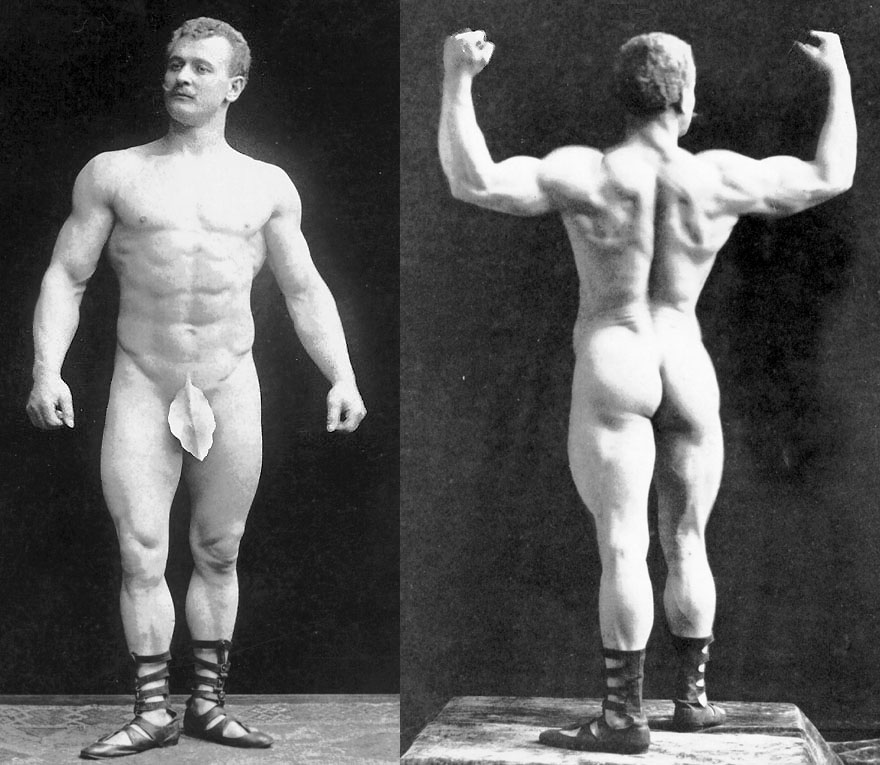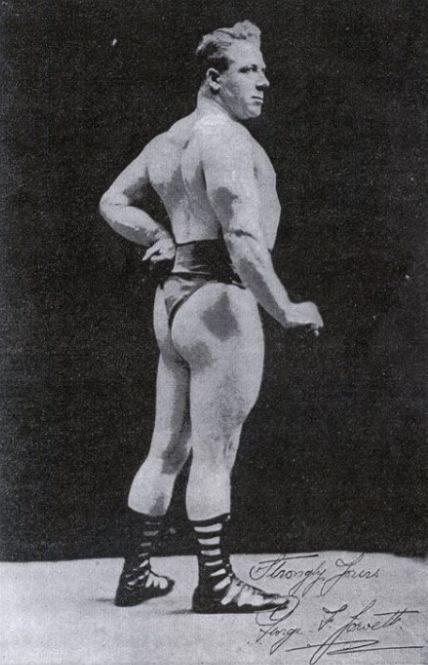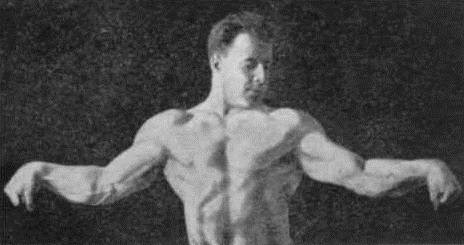Welcome to the first chapter of my series of articles that deal with a topic dear to my heart: Old School Bodybuilding.
When did bodybuilding become popular? How has this industry changed over the decades? Who were the first bodybuilders called the Bronze Era Bodybuilders?
Let’s start at the beginning, back in the late 19th century, that is called The Bronze Era Bodybuilding. Today, it remains a very unknown period to many people (not just in bodybuilding history), since education systems, schools, and global attention aren’t focused on it except for the wars that occurred and the political goals that Europe and America had at the time. Yet, this is when bodybuilding was born, along with the spread of strength culture exhibitions, feats of it in many ways, and when the first beauty contests were held.
This was a pretty chaotic time as everything was blurred between wrestlers, boxers, gymnasts, strongmen, weightlifters, bodybuilders and circus performers. Most athletes practiced many of them, if not all. They used very primitive equipment and were the pioneers of the types of equipment that modern gyms are able to provide: barbells, dumbbells, plates with the same diameter… They invented and developed many exercises, methodologies, and training protocols, which laid the foundation for the next generation of the Silver Era, followed by the Golden Era and up to our modern time.
George Hackenschmidt, the “The Russian Lion”: Strength Pioneer of the Bronze Era Bodybuilding, Creator of the Bench Press and Hack Squat
Born in 1877 in Livonia, under the Russian Empire, Hackenschmidt is one of the most impressive athletes ever. After becoming well versed in bicycle, gymnastics and swimming in school (and winning multiple events and trophies in all of these fields), he eventually chose weightlifting in order to keep moving during winter break when the other sports were off. He quickly became very strong as a wrestler and as a weightlifter. Between 1901 and 1911, his wrestling career was awe-inspiring, totaling over 3000 victories and only two losses, both to Frank Gotch, a world-class wrestler who was infamous for crippling opponents and using near-illegal techniques. Before that, he wrestled and held his own against three champions in a sports exhibition in 1896 even though he had no experience in sports besides watching them. Ironically, these athletes were the ones who pushed him to become the best and strongest man he could be.
In his school years, George could already overhead press 90kg/200lbs with one arm, but he improved to 95kg/215lbs in 1896, breaking Eugene Sandow’s world record the following year by pressing 111kg/243lbs. In early 1898, he even achieved 120kg/275lbs. His success was solely due to his smart and very hard training, inventing a lot of exercises and defining a lot of training principles and rules to follow.

George Hackenschmidt, nicknamed the “Russian Lion”. Now you know why.
As a powerful 175cm/5ft9″ and 95-102,5kg/215-225lb lifter, he was -and still is- a testament to what true naturals must struggle to achieve with a proper lifestyle. His neck measured 56cm/22″, arms at 48cm/19″, a chest at 132cm/52″ and thighs of 70cm/26,75″ in his prime. He was definitely one of the most impressive athletes ever seen.
His training to achieve the world record for one-arm presses involved pressing a barbell while lying on the floor to strengthen his shoulders and arms. The world-famous floor press was created! He continued to press 165kg/363lbs, but he didn’t stop there, thinking about ways to increase the range of motion so he could better work the entire shoulder girdle. He also popularized the wrestler bridge press, performing both a neck bridge and a pressing action at the same time, but in a more practical way by elevating his body on a bench, thus creating the well-known bench press.
Among his accomplishments, he invented one exercise during his early pro athletic career: the Hack Squat, in which he lifted a barbell from behind with his hands touching together while starting from the floor on his toes, accomplishing a world record of 85kg/187lbs. Years later, this was still done this way, sometimes with wood blocks under the feet, and it wasn’t until the sixties that a machine was developed to mimic the movement.

A Classic Physique pose that inspired countless athletes among the Bronze Era bodybuilders
Diet-wise, George believed in balance and variety. He drank close to 5L of milk per day, but he also consumed a lot of fresh fruits and vegetables, lean meats, and oatmeal. “Chocolate candy” and other sweets were partial to him, and he felt that athletes should just find what works best for them based on their training and life regimen instead of an overly structured, restrictive and rigid approach (much like what I outlined here). However, he was opposed to frequent drinking and smoking, calling it “the germ of death”. lined
Eugene Sandow, “The Father of Bodybuilding”
Considered the Father of Bodybuilding, Sandow is regarded as one of the most iconic sportsmen. Born in Prussia in 1867, he developed both his physique and sporting activities as a strongman, inspired by Ancient Greek as he had lived in Italy with his father for many years. Ludwig Durlacher, aka “Professor Attila”, noticed him as a young talent and coached him until 1889 when he encouraged his pupil to compete in a strongman contest in London. Eugene won and started to gain notoriety. Sandow was featured in some films the following year since the Edison Kenitiscope was a new invention, showing off his muscular physique (“Sandow, the modern Hercules” and “Sandow posed for his friend Thomas Edison”) and thus gaining Florenz Ziegfeld’s attention. The latter propelled Eugene as an attraction and muscle man, touring all over the US.

Eugene Sandow, the Father of Bodybuilding showcasing his “Ancient Gods” inspiration
He founded the first Institute of Physical Culture in Britain in 1897, which was followed by others in the years to come. After three years of consecutive victories, he held the first-ever physique competition in 1901, known as The Great Competition. He was one of the judges, along with Charles Lawes (a sculptor) and Arthur Conan Doyle (a writer and author). The 1st place award was a golden statue of Sandow holding a dumbbell, a silver statue for the 2nd place and a bronze one for the 3rd place (the very same awarded to Steve Reeves at Mr. Universe in 1950). Additionally, he wrote books and articles for magazines about bodybuilding and physical fitness.
Eugene’s physique was at its peak in his thirties, standing at 175cm/5ft9″ and weighing a very lean 88,5kg/195lbs. He was very strong and set a bent press record of 117,5kg/270lbs, broke chains while expanding his chest, and backflipped with 16kg/35lbs in each hand. His arms were measured at 46cm/18″ and his chest at around 122cm/48″ for a waist of 76cm/30″. His training mainly consisted of high repetitions of bodyweight and dumbbell work, calisthenics, gymnastics and some wrestling here and there. He used the first-ever pieces of machinery and cable devices in the institutes he founded, but that was much later in his career.
He mainly credited strongman training for building his bones and connective tissues so he would then be able to add muscle to them through more varied training, always in an attempt to emulate Ancient Greek sculpture’s proportions and aesthetics. He was the only showman to do this at the time, making him one of -if not- the first man who trained primarily for “cosmetic” reasons rather than functional/physical ones

Eugene Sandow during the Bronze Era of Bodybuilding
His diet was varied and non-restrictive, he just made sure the timing of his meals was right and chose only foods that he could digest well. Like many of his fellow athletes at that time, he focused more on good digestion in a stress-free environment than precise diet protocols.
George F. Jowett, “The World Most Perfectly Developed Man” of the Bronze Era Bodybuilders
Among all the forgotten legends, this gentleman deserves the least to be forgotten. Born in 1891 in Yorkshire, George’s birth was a difficult one, and he was a frail and fragile being, not expected to live beyond his teenage years. George’s sick and weak physical condition made him want to become strong just like those Victorian-era strongmen. Physical activity led him to become a gymnastic champion at the age of 15, then a boxer, wrestler and weightlifter champion, already earning titles and medals at the age of 18.
His career as a blacksmith and his involvement in the First World War led him to Canada, but his body and strength made him famous, so he returned to the US in the 1920’s to become a physical instructor. During that time, he wrote and published many books about his training, nutrition, programming, regimen and other strongmen like Louis Cyr.

George F. Jowett, the World Most Perfectly Developed Man of the Bronze Era. Seems that odd lifting and combat sports do a body good!
He was called “The World’s Most Perfectly Developed Man” despite being a rather small man for his time; he was 168cm/5ft6″ tall, weighing in his prime 90kg/200lbs, with 46cm/18″ calves, 47cm/18,5″ arms and 48,25cm/19″ neck, not to mention 71cm/27″ thighs (yes, that big). He was built like a brick house, and his strength was comparable: he could bent press with 125kg/285lbs and do one arm military press with a 65kg/140lb dumbbell, along with being able to swing and catch an anvil with his hand. In addition, he enjoyed bending steel bars, horseshoes and breaking chains on his arms and chest by flexing his muscles.
Later on, he became a successful businessman as the first inventor of standardized barbells, dumbells, and cable rows machines. In creating the ACWL and then the AAU WL meets, he set the rules of the first three weightlifting movements: Snatch, Clean & Jerk, and Clean & Press. Indeed, before then, all weightlifting meets featured odd lifts, such as bent press or back lifts. He is the creator of the very first progressive barbell system, with over sixty exercises, teaching to some of the upcoming world’s best fitness and bodybuilding legends like Bob Hoffman. Additionally, he was also the headmaster of the World War II National Fitness Plan. Last but not least, he became the first-ever IFBB President in his later years, selectedby the Weider brothers themselves.

The origin of the Crucifix pose?
Conclusion
What can we learn from these Bronze Era athletes and their bodybuilding workout routine?
- Despite what society and the current fitness industry tells us, we actually have a huge strength potential as naturals
- It takes time to create, nurture, and consolidate that potential. Most of these athletes were in their prime in their late twenties to whole thirties, after decades of regular training
- Neck training seemed to be a very key part of their routine because they were into wrestling or boxing, but also because they needed it to be strong to prevent injuries around the spine
- Odd lifts required them to have a strong grip, core and back, and are still considered fantastic exercises for forearms, abs and overall back musculature
- Your natural limit weight isn’t a mere height+5-10kg but more like 15-20kg at a healthy 10-15%BF
- They actually pushed hard on neck, forearms, traps and thighs growth potential, having some of the best-known thanks to a huge variety of training styles
- Nutritional quality and quantity are essential to fuel and recover after hard workouts. The Bronze Era Bodybuilders were known to be able to eat huge quantities at each meal
- Performing odd lifts strengthens the entire body’s tendons, ligaments, and bones, which explains why they were so resilient and rarely injured
Mate, if you are up for real natural development with healthy training and diet, check out my Personal Trainer and Nutrition Coach services. In the meantime, I warmly invite you to read my article on the Silver Era of Bodybuilding, when gyms became more popular, contests were held annually, and growth took over from strength.
Your lightkeeper,
-Hersovyac.
